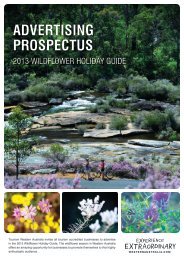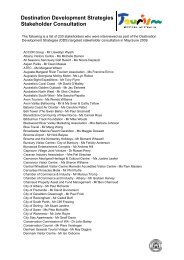TDP Experience Perth - Tourism Western Australia
TDP Experience Perth - Tourism Western Australia
TDP Experience Perth - Tourism Western Australia
You also want an ePaper? Increase the reach of your titles
YUMPU automatically turns print PDFs into web optimized ePapers that Google loves.
The development stage reflects a well defined tourism market area shapes by<br />
heavy advertising in target catchment areas. Local involvement and development<br />
typically starts to decline, superseded by larger and more up-to-date facilities<br />
provided by external organisations and chains (particularly accommodation).<br />
Natural and cultural attractions are developed and potentially supported<br />
by complementary man-made facilities. Noticeable changes in the physical<br />
appearance of the area is likely and it can be expected that not all of these<br />
changes will be welcomed by local residents. Regional, state and/or national<br />
involvement in the planning and development of facilities, as well as imported<br />
labour, will be required to cope with growing demand, as the number of visitors<br />
exceeds the local population during peak periods. The range and type of visitors<br />
will also change as broader market awareness increases.<br />
As the consolidation stage is entered, total visitor numbers continue to increase<br />
albeit at a slower rate. A major part of the areas economy is now intrinsically<br />
linked to tourism, and marketing activities become further-reaching with efforts<br />
made to extend the tourism season and catchment areas. A number of major<br />
tourism chains will now be represented, but few additions will be made. The<br />
larger number of visitors and range of tourism facilities can be expected to<br />
engender opposition from local residents not involved in the tourism industry.<br />
Defined recreational districts or hubs in the area may emerge and older tourist<br />
facilities and amenities may start to be considered less desirable.<br />
When the peak number of visitors has been reached, the area will reach the<br />
stagnation stage. Capacity levels for many tourism products and facilities will have<br />
been either reached or exceeded, leading to potential environmental, social and<br />
economic problems. By this stage, the area will usually have a well established<br />
image in the marketplace, but will no longer be fashionable. There will be surplus<br />
capacity, requiring greater marketing efforts to maintain current visitor levels. As a<br />
result, there is heavier reliance on repeat visitation and organised mass tourists.<br />
In the decline stage, the area will not be able to compete with newer and more<br />
fashionable destinations in the region and will experience a decline in visitor<br />
numbers. As a result, turnover of tourism developments and operators towards<br />
non-tourism operations becomes high as the area becomes less attractive<br />
to tourists and the viability of tourism operations becomes more difficult.<br />
Opportunities may arise for local residents to take over smaller tourism operations<br />
due to lower competition as the market declines. However, many tourism<br />
operations (particularly accommodation) are eventually converted to permanent<br />
residences (most commonly for retirees).<br />
Alternatively, it is possible that rejuvenation may occur, although the extent to<br />
which this can be achieved will usually depend on a complete change in the<br />
attractions, on which tourism is based, by either a) creating new man-made<br />
attractions, and/or b) developing previously untapped natural tourism assets.<br />
<strong>Experience</strong> <strong>Perth</strong><br />
<strong>Tourism</strong> <strong>Western</strong> <strong>Australia</strong> | <strong>Tourism</strong> Development Priorities<br />
79




![Annual Report 2002 - 2003 [pdf ] - Tourism Western Australia](https://img.yumpu.com/27124309/1/186x260/annual-report-2002-2003-pdf-tourism-western-australia.jpg?quality=85)
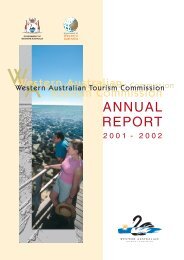
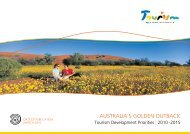


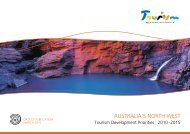
![Our Direction in China 2012 - 2015 [pdf ] - Tourism Western Australia](https://img.yumpu.com/27124271/1/184x260/our-direction-in-china-2012-2015-pdf-tourism-western-australia.jpg?quality=85)
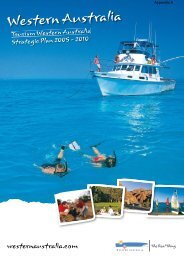

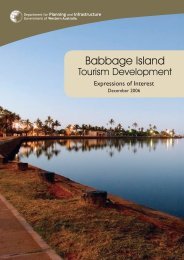
![Naturebank Program 2011 [pdf ] - Tourism Western Australia](https://img.yumpu.com/27124244/1/184x260/naturebank-program-2011-pdf-tourism-western-australia.jpg?quality=85)
